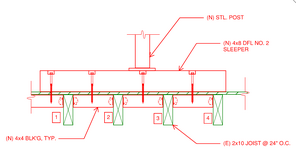seungkunoh
Structural
- May 30, 2025
- 1
Hi everyone,
I have a rooftop cell site where (2) existing joists fail under appurtenance loading (gravity only). Initial design was to install a blocking between (2) joists which fail under added load.
I was proposing to sister joists underneath, but GC proposes 4x8 DFL No. 2 sleeper to land a steel post. The sleeper sits on (4) existing 2x joists below (please see attached). Statically, I do not think sleeper can spread loads rather equally onto all (4) joists, rather most loading (gravity) should be resisted by (2) joists - Joist 2 & 3.
I have seen this approach many times by other engineers, but is it correct?
Thank you,
I have a rooftop cell site where (2) existing joists fail under appurtenance loading (gravity only). Initial design was to install a blocking between (2) joists which fail under added load.
I was proposing to sister joists underneath, but GC proposes 4x8 DFL No. 2 sleeper to land a steel post. The sleeper sits on (4) existing 2x joists below (please see attached). Statically, I do not think sleeper can spread loads rather equally onto all (4) joists, rather most loading (gravity) should be resisted by (2) joists - Joist 2 & 3.
I have seen this approach many times by other engineers, but is it correct?
Thank you,

